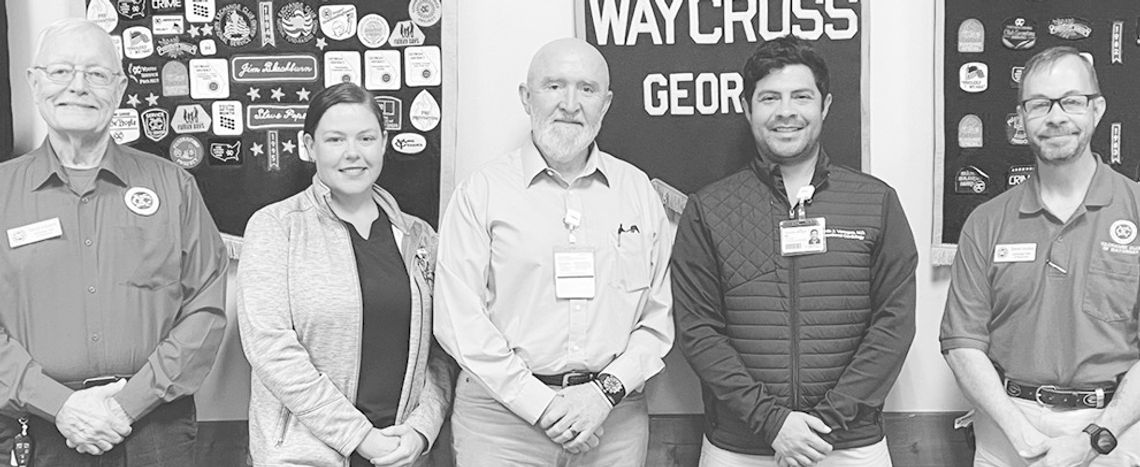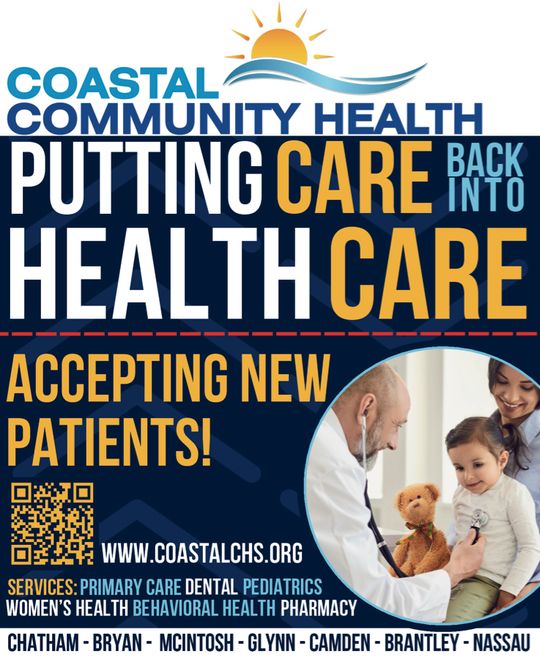The Waycross Exchange Club welcomed Dr. Eduardo Venegas, an interventional cardiologist, as the featured speaker at their weekly meeting.
Dr. Venegas provided an in-depth look into his specialized field, explaining the role of an interventional cardiologist, the advanced procedures he performs, and the state-ofthe- art care now available to the local community.
Dr. Venegas, who is board certified, trained at LSU, has a medical degree from the National Autonomous University of Honduras and did his residency at University of Miami/Palm Beach.
During his talk, he fielded a variety of questions from attendees, shedding light on heart health, minimally invasive treatments, and lifestyle factors.
• What is an Interventional Cardiologist?
Dr. Venegas distinguishing his role from that of a general cardiologist.
“Pretty much everything a general cardiologist can do, we can do,” he said. “We just have extra training in interventions.”
He described working in the catheterization lab (Cath Lab), a sterile, semioperating room environment where minimally invasive procedures are performed. These interventions, he noted, are critical for treating conditions like acute heart attacks.
“We’re well-known for handling acute heart attacks,” Dr. Venegas explained. “Patients typically come in at 3 a.m. with chest pain. Around here, we’re the only STEMI-approved center, so they end up at our hospital.”
He emphasized the hospital’s advanced equipment, capable of treating even complex cases like cardiogenic shock—a condition where the heart’s pumping ability fails due to lack of blood flow.
“We recently acquired a device to treat this locally, so patients don’t have to travel to Jacksonville,” he added, highlighting a pump that supports the heart until it recovers.
• What procedures are performed?
Dr. Venegas detailed a common procedure — coronary angiography and stenting, typically accessed through the wrist via the radial artery.
“We use numbing medication and sedation, then guide a wire and catheter to the heart,” he said. “We inject dye and use real-time X-ray to see blockages, fixing them with balloons or stents.”
The procedure itself takes about 15 minutes, with preparation bringing the total time to roughly an hour — far less invasive than open-heart surgery, which involves cracking the chest open and stopping the heart.
“Five to 1- years ago, we accessed through the groin more often,” he noted, “but the field has changed tremendously. Now, we can send patients home the same day, though our hospital keeps them for 24 hours as a precaution.”
He contrasted this with open-heart surgery’s lengthy recovery, stressing that interventional procedures are not inferior and often better suited for highrisk patients, like diabetics, depending on their anatomy.
• What conditions are treated?
“Mostly coronary artery disease,” Dr. Venegas answered when asked about the conditions he addresses.
This involves blockages in the arteries feeding the heart muscle, causing symptoms like chest pain, shortness of breath, or heart failure.
“We open those vessels with a wire, balloon and stent,” he explained, noting advanced tools like miniature ultrasounds that provide detailed images of the artery’s interior. For calcified vessels, specialized balloons break up calcium deposits to ensure proper stent placement.
“This is state-of-the-art equipment you’d typically see in bigger hospitals. I insisted on bringing it here so patients don’t have to travel,” he emphasized benefitting the Waycross community.
• Benefits of minimally invasive procedures
Attendees were curious about the advantages of these techniques.
“It’s just a small puncture — like an injection,” Dr. Venegas said. “We close it with a balloon, and patients wear a band for an hour. They can go home the same day or next day, with no heavy lifting for two weeks.”
He contrasted this with the extended hospital stays and physical therapy required after surgery, noting that patients feel little during the procedure beyond a numbing sting.
• Angioplasty vs. stenting A technical question arose about the difference between angioplasty and stenting.
“Angioplasty is inflating a balloon to open the vessel,” Dr. Venegas clarified. “Without a stent, the vessel often recoils or re-blocks. Stenting prepares the vessel and leaves a metal scaffold that stays forever, reducing that risk.”
He reassured attendees stent infections are rare due to the high-pressure arterial system.
• Causes of Atrial Fibrillation (AFib) When asked about AFib, Dr. Venegas identified age as the primary cause.
“Past 70, it’s very common,” he said, attributing it to remodeling of the heart’s upper left chamber.
Other triggers include hypertension, diabetes or stress from surgery or trauma. He discussed treatment debates — whether to control the heart rate or restore normal rhythm — noting that newer studies favor rhythm restoration via ablation or medication, paired with anticoagulation to prevent clots.
• Aspirin use and diet On the topic of aspirin, Dr. Venegas cited recent data.
“Above 75, without a clear indication, it just increases bleeding risk without benefit,” he said.
Dr. Venegas recommended consulting a doctor to weigh risks versus benefits. Regarding diet, he dismissed specific food restrictions, focusing instead on weight management and cholesterol control.
“If you eat fewer calories than you burn, you’ll lose weight — simple as that,” he said. Statins, he added, are key for managing cholesterol in coronary disease patients.
• Pacemakers and defibrillators Explaining the difference, Dr. Venegas said, “A pacemaker corrects slow heart rates or conduction issues, kicking in when needed. A defibrillator, which includes a pacemaker, delivers shocks for life-threatening rhythms like ventricular tachycardia.”
He noted these are often indicated for patients with scar tissue from past heart attacks.
• Preventing heart attacks and strokes “Risk factors and symptoms guide us,” he said. “Smoking, hypertension, diabetes, obesity — these build plaque. If symptoms like chest pain appear, we test and treat.
“For strokes, 20-30 percent stem from carotid artery plaque, which we can address surgically or with stents, though surgery is the gold standard.”
• Recovery and Lifestyle Changes Post-procedure recovery is swift, with minimal restrictions, Dr. Venegas reiterated. For prevention, he recommended 150 minutes of moderate exercise weekly — like brisk walking — along with managing risk factors.
“More exercise isn’t necessarily better,” he cautioned. “Marathon runners might even accelerate blockages.”
Dr. Venegas concluded by inviting further questions, emphasizing his commitment to bringing cutting-edge care to Waycross. His talk left attendees informed and reassured about the advanced cardiac options now available close to home.








